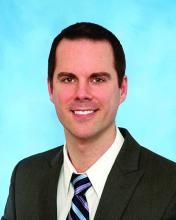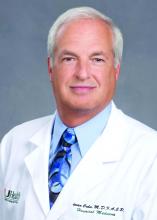User login
ORLANDO – Michael Rothberg, MD, a nocturnist who works at Presbyterian Rust Medical Center in Albuquerque, often is torn when asked to routinely perform preoperative tests, such as ECGs, on patients.
On the one hand, Dr. Rothberg knows that for many patients there is almost certainly no benefit to some of the tests. On the other hand, surgeons expect the tests to be performed – so, for the sake of collegiality, patients often have tests ordered that hospitalists suspect are unnecessary.
This was a big part of why Dr. Rothberg decided to come a day early to HM18, held in early April in Orlando, to attend the pre-course “Essentials of Perioperative Medicine and Co-Management for the Hospitalist.” He was looking for expert guidance on which patients need what tests before surgery, and also how to better determine what preoperative tests are a waste of time and money for certain patients, so that he’ll be armed with useful information when he went back to his medical center.
“I can slap something on the surgeon’s desk and say, ‘Here’s why we’re not doing it,’ ” Dr. Rothberg said.
At the HM18 pre-course, experts gave guidance on the benefits of hospitalist involvement in perioperative care and offered points to consider when assessing cardiac and pulmonary risk before surgeries. Hospitalists then broke into groups to brainstorm techniques that could improve their perioperative work.
She noted how surgical safety checklists have been shown to improve morbidity and mortality, as seen with a checklist developed by the World Health Organization and in California, where an enhanced recovery program at 20 hospitals has been successful.
“I think the reason we see changes in each of those … from pre to post when they implement, is because people start to communicate and collaborate,” she said. “I think that’s the secret sauce, and you can take that back home with you.”
Assessing risk
As for preoperative testing, history is replete with examples of tests once considered crucial but that have proven to be unimportant for many patients, including preoperative carotid endarterectomy, preop ECG, preop coronary revasularization, and preop lab work.
“I was always listening for bruits years ago,” Dr. Grant said. “I’ve sort of stopped doing that now. You’ll hear it, you won’t know what to do with it. We used to take care of those things before surgery. We now know that’s not helpful for patients without symptoms.”
Dr. Cohn’s philosophy is to not suggest a delay without firm evidence that it is necessary. “I try not to interfere with surgery unless I feel that there is significant risk,” he said.
In workshop discussions at the HM18 pre-course, hospitalists considered their contributions to preoperative care and ways they might be able to contribute more effectively. Among their ideas were better communication with anesthesiology – regarded as severely lacking by many hospitalists in the session – as well as designating smaller perioperative teams to foster knowledge and greater trust with surgeons.
Aron Mednick, MD, FHM, director of the comanagement service at Tisch Hospital, NYU Langone Medical Center, New York, said his group talked about an “identify, mitigate, propose, and resolve” method – identifying services or conditions with a high rate of preoperative problems, finding data on how to solve them, and proposing ways to get hospitalists involved in the solution.
“We noted that a lot of people experience resistance with getting hospitalists involved in care early,” he said. “So one of the ways to do this is actually to identify problems and start above the surgeon, at the CMO and COO level, and then move down through department chairs and, basically, impose our existence on the care of the patient.”
ORLANDO – Michael Rothberg, MD, a nocturnist who works at Presbyterian Rust Medical Center in Albuquerque, often is torn when asked to routinely perform preoperative tests, such as ECGs, on patients.
On the one hand, Dr. Rothberg knows that for many patients there is almost certainly no benefit to some of the tests. On the other hand, surgeons expect the tests to be performed – so, for the sake of collegiality, patients often have tests ordered that hospitalists suspect are unnecessary.
This was a big part of why Dr. Rothberg decided to come a day early to HM18, held in early April in Orlando, to attend the pre-course “Essentials of Perioperative Medicine and Co-Management for the Hospitalist.” He was looking for expert guidance on which patients need what tests before surgery, and also how to better determine what preoperative tests are a waste of time and money for certain patients, so that he’ll be armed with useful information when he went back to his medical center.
“I can slap something on the surgeon’s desk and say, ‘Here’s why we’re not doing it,’ ” Dr. Rothberg said.
At the HM18 pre-course, experts gave guidance on the benefits of hospitalist involvement in perioperative care and offered points to consider when assessing cardiac and pulmonary risk before surgeries. Hospitalists then broke into groups to brainstorm techniques that could improve their perioperative work.
She noted how surgical safety checklists have been shown to improve morbidity and mortality, as seen with a checklist developed by the World Health Organization and in California, where an enhanced recovery program at 20 hospitals has been successful.
“I think the reason we see changes in each of those … from pre to post when they implement, is because people start to communicate and collaborate,” she said. “I think that’s the secret sauce, and you can take that back home with you.”
Assessing risk
As for preoperative testing, history is replete with examples of tests once considered crucial but that have proven to be unimportant for many patients, including preoperative carotid endarterectomy, preop ECG, preop coronary revasularization, and preop lab work.
“I was always listening for bruits years ago,” Dr. Grant said. “I’ve sort of stopped doing that now. You’ll hear it, you won’t know what to do with it. We used to take care of those things before surgery. We now know that’s not helpful for patients without symptoms.”
Dr. Cohn’s philosophy is to not suggest a delay without firm evidence that it is necessary. “I try not to interfere with surgery unless I feel that there is significant risk,” he said.
In workshop discussions at the HM18 pre-course, hospitalists considered their contributions to preoperative care and ways they might be able to contribute more effectively. Among their ideas were better communication with anesthesiology – regarded as severely lacking by many hospitalists in the session – as well as designating smaller perioperative teams to foster knowledge and greater trust with surgeons.
Aron Mednick, MD, FHM, director of the comanagement service at Tisch Hospital, NYU Langone Medical Center, New York, said his group talked about an “identify, mitigate, propose, and resolve” method – identifying services or conditions with a high rate of preoperative problems, finding data on how to solve them, and proposing ways to get hospitalists involved in the solution.
“We noted that a lot of people experience resistance with getting hospitalists involved in care early,” he said. “So one of the ways to do this is actually to identify problems and start above the surgeon, at the CMO and COO level, and then move down through department chairs and, basically, impose our existence on the care of the patient.”
ORLANDO – Michael Rothberg, MD, a nocturnist who works at Presbyterian Rust Medical Center in Albuquerque, often is torn when asked to routinely perform preoperative tests, such as ECGs, on patients.
On the one hand, Dr. Rothberg knows that for many patients there is almost certainly no benefit to some of the tests. On the other hand, surgeons expect the tests to be performed – so, for the sake of collegiality, patients often have tests ordered that hospitalists suspect are unnecessary.
This was a big part of why Dr. Rothberg decided to come a day early to HM18, held in early April in Orlando, to attend the pre-course “Essentials of Perioperative Medicine and Co-Management for the Hospitalist.” He was looking for expert guidance on which patients need what tests before surgery, and also how to better determine what preoperative tests are a waste of time and money for certain patients, so that he’ll be armed with useful information when he went back to his medical center.
“I can slap something on the surgeon’s desk and say, ‘Here’s why we’re not doing it,’ ” Dr. Rothberg said.
At the HM18 pre-course, experts gave guidance on the benefits of hospitalist involvement in perioperative care and offered points to consider when assessing cardiac and pulmonary risk before surgeries. Hospitalists then broke into groups to brainstorm techniques that could improve their perioperative work.
She noted how surgical safety checklists have been shown to improve morbidity and mortality, as seen with a checklist developed by the World Health Organization and in California, where an enhanced recovery program at 20 hospitals has been successful.
“I think the reason we see changes in each of those … from pre to post when they implement, is because people start to communicate and collaborate,” she said. “I think that’s the secret sauce, and you can take that back home with you.”
Assessing risk
As for preoperative testing, history is replete with examples of tests once considered crucial but that have proven to be unimportant for many patients, including preoperative carotid endarterectomy, preop ECG, preop coronary revasularization, and preop lab work.
“I was always listening for bruits years ago,” Dr. Grant said. “I’ve sort of stopped doing that now. You’ll hear it, you won’t know what to do with it. We used to take care of those things before surgery. We now know that’s not helpful for patients without symptoms.”
Dr. Cohn’s philosophy is to not suggest a delay without firm evidence that it is necessary. “I try not to interfere with surgery unless I feel that there is significant risk,” he said.
In workshop discussions at the HM18 pre-course, hospitalists considered their contributions to preoperative care and ways they might be able to contribute more effectively. Among their ideas were better communication with anesthesiology – regarded as severely lacking by many hospitalists in the session – as well as designating smaller perioperative teams to foster knowledge and greater trust with surgeons.
Aron Mednick, MD, FHM, director of the comanagement service at Tisch Hospital, NYU Langone Medical Center, New York, said his group talked about an “identify, mitigate, propose, and resolve” method – identifying services or conditions with a high rate of preoperative problems, finding data on how to solve them, and proposing ways to get hospitalists involved in the solution.
“We noted that a lot of people experience resistance with getting hospitalists involved in care early,” he said. “So one of the ways to do this is actually to identify problems and start above the surgeon, at the CMO and COO level, and then move down through department chairs and, basically, impose our existence on the care of the patient.”
REPORTING FROM HM18



